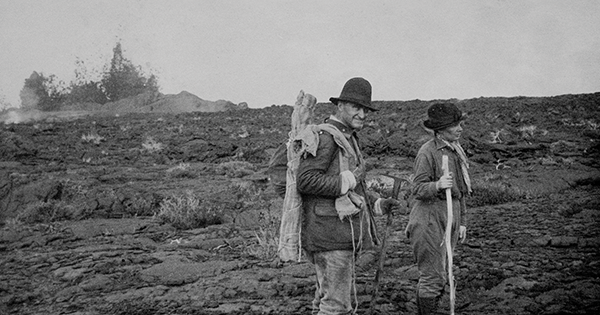
The Last Volcano: A Man, a Romance, and the Quest to Understand Nature’s Most Magnificent Fury by John Dvorak; Pegasus Books, 309 pp., $28.95
In May 1902, Mount Pelée on the Caribbean island of Martinique erupted, destroying the city of St. Pierre. According to reports, 25,000 people were killed, yet even the experts thought the death toll exaggerated—a volcano couldn’t cause such devastation. Despite this skepticism, the U.S. government quickly dispatched a ship carrying supplies and several scientists, including Harvard geologist Thomas Jaggar, to provide humanitarian assistance and determine what had happened.
When they arrived, Jaggar and the other scientists found a modern-day Pompeii. No buildings remained standing. A thick layer of volcanic ash covered the ruins, and corpses lay everywhere. Taking in the scene, Jaggar wondered why, so many centuries after the catastrophic eruption of Mount Vesuvius, human knowledge had not advanced enough to prevent such suffering.
Jaggar had first become interested in volcanoes as a teenager during a trip to Italy, where he and his family visited Vesuvius and the remains of Pompeii. But it was this expedition to the Caribbean, during which he explored several volcanoes and interviewed survivors of the St. Pierre disaster, that cemented his lifelong devotion to studying the mysterious mountains. “It was an ideal—and ideals come at a price,” John Dvorak writes in The Last Volcano. That price, however—his cozy life in Boston and the happiness of his wife and children—appears one that Jaggar was more than willing to pay.
The Mount Pelée eruption occurred decades before scientists knew how volcanoes formed or why earthquakes were more common in some locations than others. Even simple facts, such as the temperature of lava and the composition of volcanic gases, were unknown. But geological knowledge was growing rapidly, and in 1909, when Jaggar gazed into the lava-filled crater of the Kilauea volcano on Hawaii, he saw an opportunity. Until then, scientists had studied geological disasters, such as St. Pierre or San Francisco—where a magnitude-7.8 earthquake destroyed 80 percent of the city in 1906—only after they had occurred. But if geological observatories could be established all over the world, scientists might be able to track conditions inside the planet and issue warnings when disaster approached. At the time, the slopes of Mount Vesuvius were home to the world’s only such observatory, so Jaggar founded a second one on Kilauea.
Jaggar’s wife, Helen, was not keen on this plan. Hawaii may be a paradise, but for her, the move from Boston to an isolated, two-room house on top of a volcano was more than she could bear. Within weeks, she moved out with the Jaggars’ two children, escaping to her parents’ home in San Francisco, and eventually sued for divorce. Jaggar seems to have been little affected by this and only rarely saw his children after they left Hawaii.
His second wife, Isabel Maydwell, was more sympathetic and proved to be a skillful research assistant and volcano observer. With help from her and a parade of experts and assistants, Jaggar went on to make crucial discoveries about the nature of volcanoes. For example, it was known that earthquakes forewarned of eruptions, but Jaggar showed that even small quakes, too minor to be felt, could also presage eruptions. Today, seismic recordings are at the heart of earthquake prediction, Dvorak notes, and a sudden flurry of quakes is considered one of the best indicators that an eruption is imminent. Jaggar’s many attempts to measure the temperature of Kilauea’s lava eventually showed that the molten lake was a whopping 2,010 degrees Fahrenheit—a temperature confirmed after Jaggar’s death. And gas samples he collected during the 1919 eruption of Hawaii’s Mauna Loa—which showed that volcanic gases consisted mostly of water vapor and carbon dioxide—remain the best ever taken from that volcano.
[adblock-left-01]
Jaggar’s thrilling adventures to volcanic hot zones like Alaska and Hawaii, where he explored inside active volcanoes, makes one appreciate the fearless nature required for a life of volcanology. To be sure, Jaggar’s exploits were not free of the more prosaic and annoying aspects of doing science—fights with university administrators and the never-ending quest for funding—but Dvorak’s focus on his subject’s obsession with deadly geology is so riveting that it leaves readers wanting to know more about how volcanology has advanced since Jaggar’s day.
More than a century later, earthquakes and volcanoes remain as unpredictable as they are deadly. But Jaggar’s dream of a network of observatories has been fulfilled. Seismic data now flow from sensors and satellites to computers and geologists worldwide. Whether we will be able to make use of all this information to prevent another Pompeii or St. Pierre isn’t clear, but that we are trying is a testament to Jaggar’s legacy.

